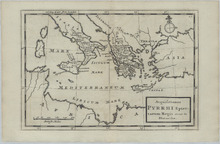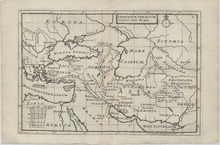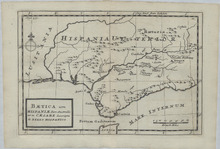Acquisitiones Pyrrhi Epirotarum Regis sicut in Plutarcho (1739)
Copper engraved historic map showing the Kingdom of Pyrrhus of Epirus, based on the sources of Plutarch. The map depicts the Southern tip of Italy, Sardinia, Corsica, Greece, Crete, the Northern tip of the African Continent, Croatia, Albania, Macedonia, and Turkey. The map is filled with a lot of geographic details concerning place names in Latin, Rivers, Mountains, and Islands. The title is inside a simple cartouche. Cities, Rivers, Towns, and Seas shown: Italia (Italy), Illyricum (Present day Croatia, Bosnia and Herzegovina, and Albania), Roma (Rome), Samnites (People of South-Central Italy), Ferentium (Absorbed by Modern-day Viterbo), Asculum (Ascoli Satriano), Beneventum (Benevento), Apulia, Messapia (Salento), Hydruntum (Otranto), Heraclea Lucania (Roman town abandoned before the 19th Century), Magna Graecia, Mare Mediterraneum (Mediterranean Sea), Castella Mamerti Norum, Messana (Messina), Eryae, Agrigentum (Agrigento), Sicilia (Sicily), Leontium, Syracuse, Carthago (Carthage), Africa, Libicum Mare, Siculum Mare, Tarentum (Taranto), Graecia (Greece), Nimphea, Pieria Megares, Macedonia, Epirus (Modern-day Greece and Albania), Edessa, Paeonia (Paionia), Chaonia (Modern day Western Greece), Passaron, Berea (Veria), Coreyra Island, Tresprotia, Berenicea, Ambracia (Arta), Dodona (Greek city that dwindled sometime after 431 AD), Aegea, Thessalia (Thessaly), Peneus F., Pineios River), Amphilechia, Amphilechia, Aetolia, Phocis, Attica, Athenae (Athens), Nysea, Corinthus (Corinth), Peloponnesus (Peloponnese), Argos, Megalopolis (Megalopoli), Neapolis, Cilarbis, Tegea (Alea), Lernae, Sparta, Thracia, Troja (Troy), Asia, Creta I. (Crete Island), Aptera, and Gortyna (Gortyn). The source publication is: Geographia antique, Latinorum et Graecorum, tabulis XXXII novis & accuratis expressa, translated: Thirty-two new and accurate maps of the geography of the ancients, as contained in the Greek and Latin Classics. It was printed and sold in 1739 in London by Thomas Bowles. Herman Moll was a Dutchman bookseller, geographer and engraver. Around 1678 he moved to London where for a while he continued as an engraver. Later, he started his own businesses a map publisher and by the turn of the century had become the most prominent map publisher in the country. He published atlases and loose maps of all parts of the world many of which were highly decorative. In 1724 he published his 'New Description of England and Wales', an atlas of the English and Welsh Counties. He had many interesting friends including Daniel Defoe, Jonathan Swift (for whom he provided maps for Robinson Crusoe and Gulliver's Travels), explorers William Damier and Woodes Rogers, and the scientist Robert Hooke.
Member of


